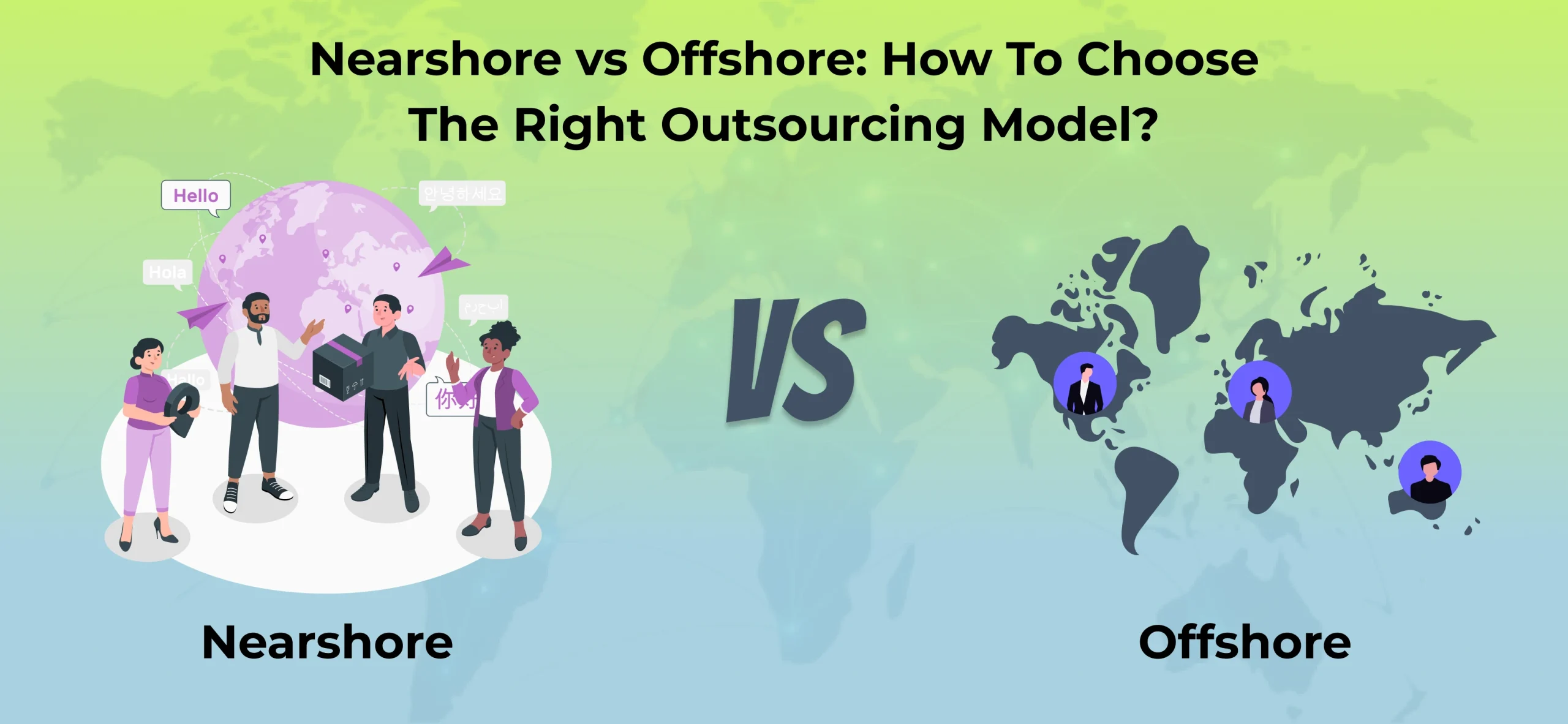Businesses today are constantly searching for smarter ways to expand, with outsourcing becoming one popular solution – hiring outside experts to complete certain projects on behalf of businesses. This is becoming ever-more common as it helps save both money and focus on core goals – saving both both time and resources in the process. This trend aids both time- and cost-cutting.
When considering outsourcing options, nearshore or offshore outsourcing are typically your two primary options. Each has distinct benefits; choosing one over the other is crucial to the success of your project – your decision could affect everything from communication costs to project timelines.
This blog will outline the key differences between nearshoring and offshoring models to assist your understanding. Understanding your unique business requirements and learning about nearshore and offshore options available to you will enable you to make an educated choice between nearshore and offshore options for the benefit of your organization.
Understanding Nearshore Outsourcing
Nearshore outsourcing refers to working with third-party service providers located within close geographic and cultural distance, for instance Mexico or Canada may offer greater economic and cultural affinities, making the choice between nearshoring and offshore outsourcing simpler for some companies.
Pros
Improved Communication: By working across similar time zones, real-time discussions become simpler while communication delays and language barriers decrease; providing clearer instructions and feedback for all.
Cultural Align: Countries nearby typically share similar cultural norms and business practices, helping minimize any miscommunication between your internal team and any outsourced teams; leading to smoother working relationships and less mishap.
Increased Collaboration & Oversight: Proximity allows for more frequent virtual meetings as well as simple, cost-efficient visits in person; ultimately facilitating easier project control and greater cooperation.
Rapid Response Times: Because nearshore teams are located close by time zones, they can respond more rapidly and address urgent requests and issues faster, helping keep projects on schedule.
Reduce Travel Costs/Time: Travel can become significantly less costly and time consuming when visiting teams, saving resources while making face-to-face meetings more feasible.
Increased IP Protections: Countries within similar geographic regions typically share similar legal frameworks, which could provide enhanced intellectual property (IP) and data security protections to protect your assets more efficiently as well as meet data security needs efficiently.
Cons
Higher Costs than Offshore: While more cost-effective than onshore outsourcing, nearshore rates often outstrip those from more established offshore locations due to increased labour costs in nearby countries.
Smaller Talent Pool: Comparative to offshore outsourcing’s vast global talent pool, nearshore outsourcing’s talent pool may be more limited; you might only have access to certain experts.
Still Requires Management Overhead: Even with improved communication and oversight, managing an offshore team still requires dedicating resources for effective administration – so I don’t think this process is fully hands-off.
Understanding Offshore Outsourcing
Offshore outsourcing involves sending work to third-party providers located in distant countries – often far enough that there can be significant time zone differences; think about an organization in New York hiring teams from India or the Philippines: distance is usually a key factor here.
Pros
Significant Cost Savings: Labor costs in many offshore regions tend to be substantially less expensive than their Western counterparts, leading to substantial cost-cutting benefits and savings that will boost your budget.
Access to a Global Talent Pool: Offshoring provides companies access to an expansive talent pool; experts with rare or hard-to-find talents may even find your services here.
Scalability: Offshore providers typically employ large teams that are quickly expandable or contractable based on project needs, providing businesses with fast expansion the peace of mind they require for fast expansion. This provides significant peace of mind.
24/7 Work Cycles: Due to major time differences, offshore teams can work while their in-house counterparts rest, creating an uninterrupted workflow and speedier project completion. This “follow the sun” method ensures a continuous workflow process and faster project completion times.
Cons
Communication Challenges: Due to time zone differences and language barriers, real-time discussions become challenging and clear documentation becomes paramount in order for any negotiations or agreements between two parties.
Cultural Differences: Different cultures possess diverse work ethics and communication styles that may lead to disagreement or misinterpretations between coworkers or miscommunications between colleagues. Therefore, one must be cognizant of such differences between them all.
Less Control/Oversight: Given their physical distance from you, direct management may become challenging. Keeping an eye on daily progress and monitoring daily accomplishments successfully requires reliable remote management tools and strategies.
Data Security Concerns: National laws for data protection can differ significantly; making sure your sensitive information remains safe is often an intricate task; understanding local regulations is vital here.
Longer Travel Times: Traveling overseas for meetings can be time-consuming and costly, thus limiting face-to-face collaboration opportunities.
Nearshore vs Offshore: How To Choose The Right Outsourcing Model
Selection of an outsourcing model (nearshore or offshore) that fits the unique requirements of your business is critical for its success. Each offers their own benefits and drawbacks; here is a comparison table to highlight key distinctions and assist with making this important choice between nearshore vs offshore outsourcing options.
| Feature | Nearshore Outsourcing | Offshore Outsourcing |
|---|---|---|
| Definition | Delegating work to a provider in a neighboring country with similar time zones. | Delegating work to a provider in a geographically distant country with significant time zone differences. |
| Location Example | US to Mexico/Canada; Western Europe to Eastern Europe. | US to India/Philippines; UK to Vietnam |
| Time Zone Overlap | High (often same or 1–3 hour difference) | Minimal to None (often 8–12+ hour difference) |
| Communication | Easier, more real-time, fewer language barriers. | More challenging, often asynchronous, potential language barriers. |
| Cultural Alignment | High (similar business practices and norms). | Lower (more significant cultural differences). |
| Cost Savings | Moderate (lower than onshore, generally higher than offshore). | High (significantly lower labor costs). |
| Talent Pool | Moderate (regional focus). | Vast (global access to diverse skills). |
| Control & Oversight | Easier due to proximity and better communication. | More challenging due to distance and time zones. |
| Travel | Easier, less time, lower cost for visits. | Difficult, more time-consuming, higher cost for visits. |
| IP Protection | Potentially stronger due to similar legal frameworks. | Varies, requires careful due diligence on local laws. |
| Response Times | Quicker, real-time issue resolution. | Slower, often requires waiting for next work cycle. |
| Best Suited For | Projects needing close collaboration, agile development, sensitive data, strong cultural fit. | Projects with well-defined scopes, large scale, highly cost-sensitive initiatives, 24/7 operations. |
Nearshore vs Offshore: Making the Right Choice
Making decisions between nearshoring and offshoring can seem like an intimidating challenge, but having an outline will make things simpler. Consider your project’s specific requirements when making this important choice between nearshore and offshore options. This should guide your decision effectively.
Offshore outsourcing can help achieve significant cost reduction when projects with clearly outlined tasks or scopes, such as routine tasks or large-scale data entry, are involved. Your internal team is capable of handling communication challenges without direct oversight from management, plus taking advantage of global talent pools with round-the-clock work cycles that appeal. Nearshore development should lean towards offshore for cost-driven, less interactive projects.
Nearshore outsourcing should be used when close collaboration is vital, real-time communication needs to occur across similar time zones, and stronger data protection is a requirement of your project; cultural alignment plays a significant role in team cohesiveness; agile development methods often suit nearshore teams better; or your data protection and IP requirements must be upheld with strong IP protection mechanisms in place.
An easier oversight and lower travel costs are both key benefits of employing offshore teams for back-end development or routine tasks and nearshore teams for front-end work or tasks requiring constant client interaction. Thus taking full advantage of both models’ strengths for different functions.
No matter which path you follow when making outsourcing decisions, due diligence must always come first. Carefully research potential vendors. Evaluate them thoroughly based on past projects completed as well as client testimonials. Starting small may help gauge compatibility before fully committing. Taking these steps ensures a successful outsourcing partnership.
Conclusion
As we’ve examined nearshore and offshore outsourcing models, we have examined their core differences as well as their respective advantages. When choosing between nearshore or offshore outsourcing for our business needs, carefully considering each model is key – there is no single best-fit solution out there; your decision directly affects team efficiency as well as budgetary concerns, as well as overall success – thus, selecting an outsourcing model must be treated strategically for maximum effect.
Are you searching for the ideal outsourcing solutions to expand your business? Taking careful note of your individual requirements and project goals will allow for making an optimal choice when selecting nearshore vs offshore options for growth. For assistance finding your optimal outsourcing solutions for growth needs, contact Echoinnovate now – We specialize in matching businesses like yours with outsourcing providers that meet them.
Nearshore vs Offshore: How To Choose The Right Outsourcing Model?
What is the difference between nearshore and offshore outsourcing?
Nearshore outsourcing means partnering with companies in nearby countries that share similar time zones and cultural practices. Offshore outsourcing involves working with providers in distant countries, usually with large time zone differences and different business cultures.
Which is more cost-effective: nearshore or offshore outsourcing?
Offshore outsourcing is generally more cost-effective due to significantly lower labor costs. However, nearshore outsourcing can provide better communication and collaboration, which may reduce hidden costs over time.
When should I choose nearshore outsourcing?
Nearshore outsourcing is ideal when your project requires frequent communication, real-time collaboration, cultural alignment, or agile development methods.



